-
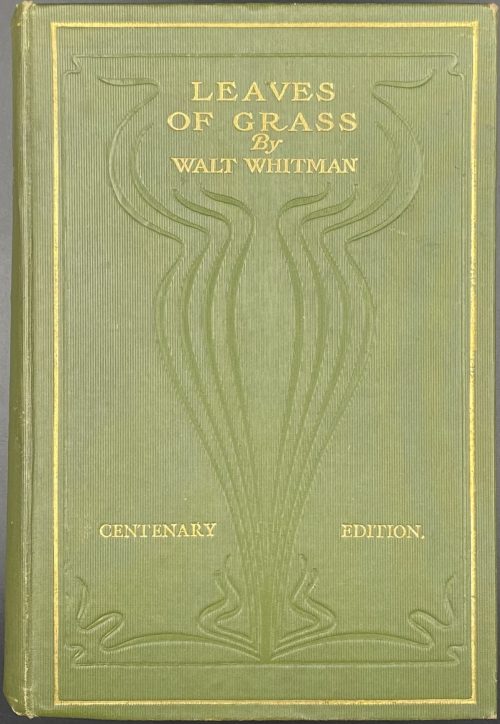 Hardcover, 21.5 x 15 cm, green buckram with gilt border and gilt lettering to front board and spine, blind decorated in art nouveau style, T.E.G. Pagination: [26] 1-294, [4] 1-323 [324], [4] 1-255 [256] [4]; total 912 pages and photo portrait frontispiece. Title-page: THREE VOLUMES IN ONE | LEAVES OF GRASS| WALT WHITMAN | ISSUED UNDER THE | EDITORIAL SUPERVISION OF HIS | LITERARY EXECUTORS, RICHARD MAURICE | BUCKE, THOMAS B. HARNED, AND | HORACE L. TRAUBEL | {device} | D. APPLETON AND COMPANY | New York […] London || For the Russian translation, see LIB-3103.2022 Уолт Уитмен. Листья травы / Пер. с англ. Вступ. статьи К. Чуковского и М. Медельсона. — М.: Государственное издательство художественной литературы, 1955. Contributors: Walter [Walt] Whitman (American, 1819 – 1892) Richard Maurice Bucke (Canadian, 1837 – 1902) Thomas Biggs Harned (American, 1851 – 1921) Horace Logo Traubel (American, 1858 – 1919)
Hardcover, 21.5 x 15 cm, green buckram with gilt border and gilt lettering to front board and spine, blind decorated in art nouveau style, T.E.G. Pagination: [26] 1-294, [4] 1-323 [324], [4] 1-255 [256] [4]; total 912 pages and photo portrait frontispiece. Title-page: THREE VOLUMES IN ONE | LEAVES OF GRASS| WALT WHITMAN | ISSUED UNDER THE | EDITORIAL SUPERVISION OF HIS | LITERARY EXECUTORS, RICHARD MAURICE | BUCKE, THOMAS B. HARNED, AND | HORACE L. TRAUBEL | {device} | D. APPLETON AND COMPANY | New York […] London || For the Russian translation, see LIB-3103.2022 Уолт Уитмен. Листья травы / Пер. с англ. Вступ. статьи К. Чуковского и М. Медельсона. — М.: Государственное издательство художественной литературы, 1955. Contributors: Walter [Walt] Whitman (American, 1819 – 1892) Richard Maurice Bucke (Canadian, 1837 – 1902) Thomas Biggs Harned (American, 1851 – 1921) Horace Logo Traubel (American, 1858 – 1919) -
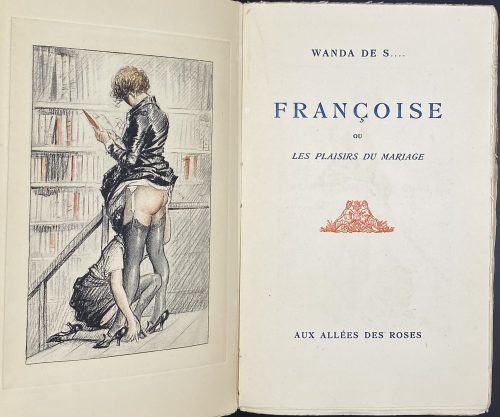 Description: Softcover, 23 x 14.5 cm, original flapped wrappers, spine and front cover lettered in blue «WANDA DE S…. | FRANÇOISE | OU | LES PLAISIRS DU MARIAGE | AUX ALLÉES DES ROSES», leaves untrimmed. Title-page: WANDA DE S…. | FRANÇOISE | OU | LES PLAISIRS DU MARIAGE | {vignette} | AUX ALLÉES DES ROSES || Collation: [1]8 (1 blank in wrapper, 1 blank, h.t., t.p., f.t.p., 3 leaves of text), 2-148 154 (uncut), 116 leaves total plus 10 hand-coloured photogravures by anonymous, extraneous to collation. Pagination: [1-10] 11-224 [8], ils.; 232 pages total. Limitation: edition under subscription, limited to 600 copies of which 100 copies (№ 1-100) on pur fil and 500 copies (№ 101-600) on Vélin, this is № 142. Edition: 1st edition thus, printed by Maurice Darantiere, illustrated with 10 full-page coloured photogravures after an anonymous artist, attributed by some to Feodor Rojankovsky [Rojan] and by some to Louis Berthomme Saint-André. According to J.-P. Dutel, the original watercolours in his collection signed Véronique. Catalogue raisonné: Dutel (1920-1970): 1605, p. 176; honesterotica.com.
Description: Softcover, 23 x 14.5 cm, original flapped wrappers, spine and front cover lettered in blue «WANDA DE S…. | FRANÇOISE | OU | LES PLAISIRS DU MARIAGE | AUX ALLÉES DES ROSES», leaves untrimmed. Title-page: WANDA DE S…. | FRANÇOISE | OU | LES PLAISIRS DU MARIAGE | {vignette} | AUX ALLÉES DES ROSES || Collation: [1]8 (1 blank in wrapper, 1 blank, h.t., t.p., f.t.p., 3 leaves of text), 2-148 154 (uncut), 116 leaves total plus 10 hand-coloured photogravures by anonymous, extraneous to collation. Pagination: [1-10] 11-224 [8], ils.; 232 pages total. Limitation: edition under subscription, limited to 600 copies of which 100 copies (№ 1-100) on pur fil and 500 copies (№ 101-600) on Vélin, this is № 142. Edition: 1st edition thus, printed by Maurice Darantiere, illustrated with 10 full-page coloured photogravures after an anonymous artist, attributed by some to Feodor Rojankovsky [Rojan] and by some to Louis Berthomme Saint-André. According to J.-P. Dutel, the original watercolours in his collection signed Véronique. Catalogue raisonné: Dutel (1920-1970): 1605, p. 176; honesterotica.com. -
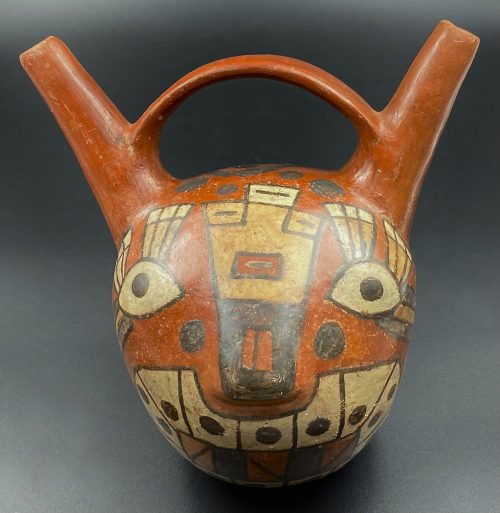 Pre-Columbian, Peru, Wari (Huari) culture, ca. 650 to 1000 CE.
Pre-Columbian, Peru, Wari (Huari) culture, ca. 650 to 1000 CE.A hand-built polychrome ceramic stirrup vessel depicting the head of a jaguar. Painted with a sienna-hued base, this spotted beast features an abstract visage of almond-shaped eyes opened wide with long feather-like lashes, a rectangular nose protruding from a nasal bridge decorated with a quadrilateral motif, and a large open mouth, showing both upper and lower teeth, which are also spotted, all painted in shades of cream, black, cream, grey, light grey, and beige. Highly burnished, the lustrous vessel exhibits two spouts, also functioning as ears of the jaguar, with a flat handle arching between them. This tool would have been a grave good intended to hold some kind of libation or offering and was likely made in a specialist workshop.
Colours: Sienna (base), black, cream, grey, light grey, beige (7 colours).
Dimension: Width (mouth-to-mouth): 15 cm; Height: 14.5 cm; Diameter of the body: 10.5 cm. Provenance: Hans Juergen Westermann collection, Germany. The Wari State was the first expansionistic power to develop in the Andean highlands. It was located in Vilcabamba, modern Espiritu Pampa (Plain of the Spirits), Echarate District of La Convención Province in the Cuzco Region of Peru. The Wari expanded around AD 650 and by the time of their collapse in AD 1000 they controlled much of the central Andes. -
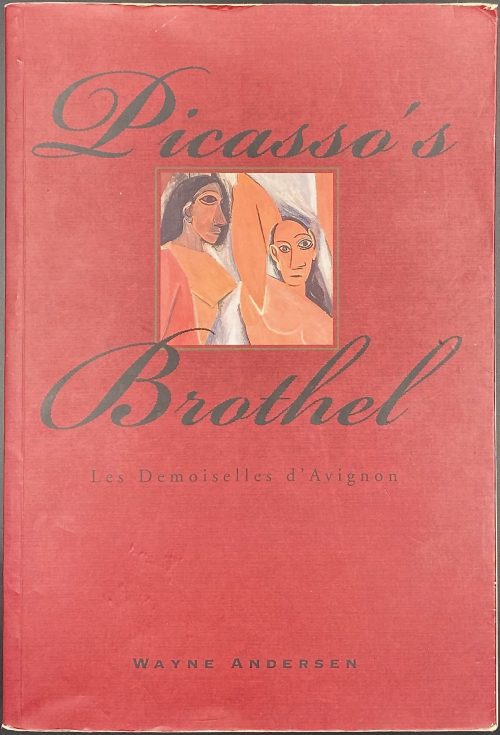 Paperback, 25.3 x 17.3 cm, burgundy flapped wrappers, pp.: [i-vii] viii-x, [2] [1] 2-356. Front wrapper: Picasso's | {vignette} | Brothel | Les Demoiselles d'Avignon | Wayne Andersen || Title-page: PICASSO'S BROTHEL | LES DEMOISELLES D'AVIGNON | — | WAYNE ANDERSEN | {publisher’s device} | Other Press | New York || Wayne Andersen (American, 1928 – 2014) Pablo Picasso (Spanish, 1881 – 1973) Les Demoiselles d'Avignon
Paperback, 25.3 x 17.3 cm, burgundy flapped wrappers, pp.: [i-vii] viii-x, [2] [1] 2-356. Front wrapper: Picasso's | {vignette} | Brothel | Les Demoiselles d'Avignon | Wayne Andersen || Title-page: PICASSO'S BROTHEL | LES DEMOISELLES D'AVIGNON | — | WAYNE ANDERSEN | {publisher’s device} | Other Press | New York || Wayne Andersen (American, 1928 – 2014) Pablo Picasso (Spanish, 1881 – 1973) Les Demoiselles d'Avignon -
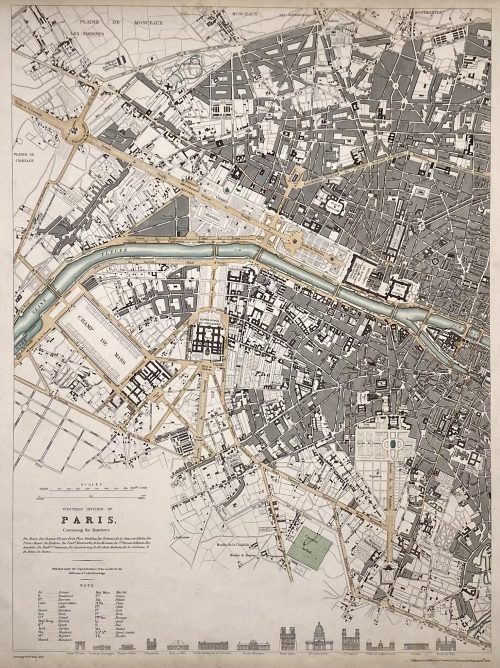 WESTERN DIVISION OF | PARIS. | Containing the Quartiers | {4 lines in italic} | Published under the Superintendence of the Society for the | Diffusion of Useful Knowledge || Under the frame: Drawn by W. B. Clarke, Archt. […] Published by Baldwin & Cradock, 47 Paternoster Row, April 1st. 1834. Dimensions: Sheet: 40.5 x 34.5 cm; Image: 39 x 28.8 cm. Contributors: William Barnard Clarke (British, 1806 – 1865) – artist. John Shury (fl. c. 1814-1844) – engraver. Baldwin & Cradock (London) – publisher. Society for the Diffusion of Useful Knowledge (SDUK) (British firm, 1826 – 1846).
WESTERN DIVISION OF | PARIS. | Containing the Quartiers | {4 lines in italic} | Published under the Superintendence of the Society for the | Diffusion of Useful Knowledge || Under the frame: Drawn by W. B. Clarke, Archt. […] Published by Baldwin & Cradock, 47 Paternoster Row, April 1st. 1834. Dimensions: Sheet: 40.5 x 34.5 cm; Image: 39 x 28.8 cm. Contributors: William Barnard Clarke (British, 1806 – 1865) – artist. John Shury (fl. c. 1814-1844) – engraver. Baldwin & Cradock (London) – publisher. Society for the Diffusion of Useful Knowledge (SDUK) (British firm, 1826 – 1846). -
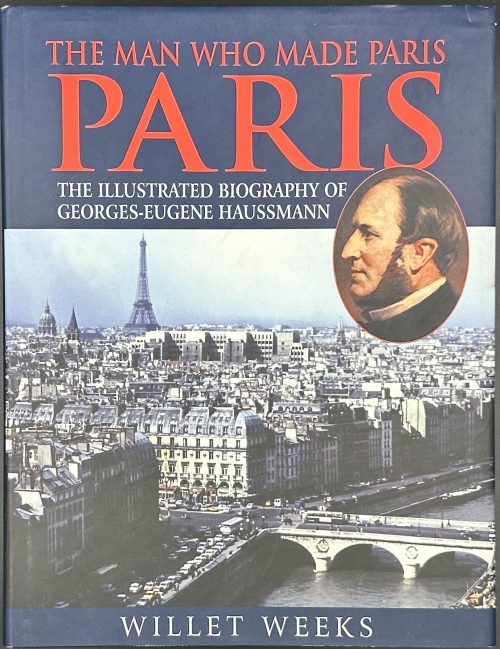 Hardcover volume, 25.3 x 19.6 cm, bound in blue cloth, gilt lettering to spine, pictorial dust jacket, crimson endpapers, pp.: [1-4] 5-160, ils. Title-page: THE MAN WHO MADE PARIS | PARIS | THE ILLUSTRATED BIOGRAPHY OF | GEORGES-EUGENE HAUSSMANN | WILLET WEEKS | Photographer of | scenes of Paris today | JEAN-CLAUDE MARTIN | (in frame) LONDON / HOUSE || Contributors: Willet Weeks (American)– author. Jean-Claude Martin (French-American) – photographer. Georges Eugène Haussmann (French, 1809 – 1891) – character.
Hardcover volume, 25.3 x 19.6 cm, bound in blue cloth, gilt lettering to spine, pictorial dust jacket, crimson endpapers, pp.: [1-4] 5-160, ils. Title-page: THE MAN WHO MADE PARIS | PARIS | THE ILLUSTRATED BIOGRAPHY OF | GEORGES-EUGENE HAUSSMANN | WILLET WEEKS | Photographer of | scenes of Paris today | JEAN-CLAUDE MARTIN | (in frame) LONDON / HOUSE || Contributors: Willet Weeks (American)– author. Jean-Claude Martin (French-American) – photographer. Georges Eugène Haussmann (French, 1809 – 1891) – character. -
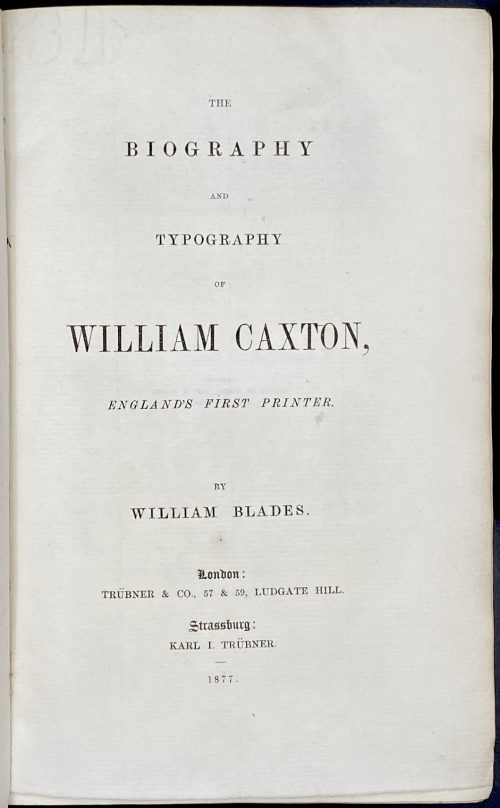 Title: THE | BIOGRAPHY AND | TYPOGRAPHY | OF | WILLIAM CAXTON, | ENGLAND'S FIRST PRINTER. | BY | WILLIAM BLADES. | LONDON : | TRÜBNER & CO, 57 & 59 LUDGATE HILL. | STRASSBURG : | KARL I. TRÜBNER. | 1877. || Pagination: ffl, [2] blank, [i, ii] - t.p., imprint, [iii], iv, v - preface, [vi] - cul-de-lampe, [vii], viii - contents; [1], 2-383 [384] - imprint, 2] - blanks, bfl.; 18 plates: op. p. 8, 22, 54 (3), 60, 126 (4), 283, [311], 336, 358 (5). Collation: 8vo; [A]4 B-Z8 AA8 BB7. Exterior: 22.6 x 14.8 cm, printed on watermarked Zanders laid paper, original brown decorated paper boards, spine with decoration and lettering, marbled end-papers, water stain to bottom of upper cover, slightly rubbed, upper margin marbled, other untrimmed, binder's mark to back pastedown: "Bound by Simpson & Renshaw". Bookplates to front pastedown: upper: F. Marcham | Tempora mutantur, nos et mutamur in illis. | Hornsey | 1907"; lower: (2) "From the library of | H. Harvey Frost". Caxton, William (British, c. 1422 – 1491). Blades, William (British, 1824-1890) Frank Marcham (1883 – 1934), motto: "Times are changed, we also are changed with them". This book is based on the author's The Life and Typography of William Caxton, London: J. Lilly, 1861-63, – "A new 'Life' in a more handy form".
Title: THE | BIOGRAPHY AND | TYPOGRAPHY | OF | WILLIAM CAXTON, | ENGLAND'S FIRST PRINTER. | BY | WILLIAM BLADES. | LONDON : | TRÜBNER & CO, 57 & 59 LUDGATE HILL. | STRASSBURG : | KARL I. TRÜBNER. | 1877. || Pagination: ffl, [2] blank, [i, ii] - t.p., imprint, [iii], iv, v - preface, [vi] - cul-de-lampe, [vii], viii - contents; [1], 2-383 [384] - imprint, 2] - blanks, bfl.; 18 plates: op. p. 8, 22, 54 (3), 60, 126 (4), 283, [311], 336, 358 (5). Collation: 8vo; [A]4 B-Z8 AA8 BB7. Exterior: 22.6 x 14.8 cm, printed on watermarked Zanders laid paper, original brown decorated paper boards, spine with decoration and lettering, marbled end-papers, water stain to bottom of upper cover, slightly rubbed, upper margin marbled, other untrimmed, binder's mark to back pastedown: "Bound by Simpson & Renshaw". Bookplates to front pastedown: upper: F. Marcham | Tempora mutantur, nos et mutamur in illis. | Hornsey | 1907"; lower: (2) "From the library of | H. Harvey Frost". Caxton, William (British, c. 1422 – 1491). Blades, William (British, 1824-1890) Frank Marcham (1883 – 1934), motto: "Times are changed, we also are changed with them". This book is based on the author's The Life and Typography of William Caxton, London: J. Lilly, 1861-63, – "A new 'Life' in a more handy form". -
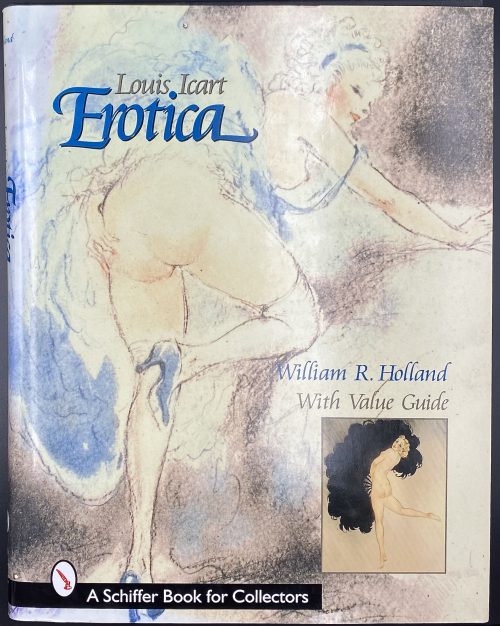 Pictorial title page in blue and black: Louis Icart | Erotica | William R. Holland | {vignette} | Schiffer | Publishing Ltd | 4880 Lower Valley Road, Atglen, PA 19310 USA || Pagination: [1-6] 7-175 [176], plates within pagination. Binding: black cloth, blue lettering to front cover and spine, marbled endpapers, pictorial dust jacket: Louis Icart | Erotica | William R. Holland | With Value Guide | A Schiffer book for collectors || Contributors: Louis Icart (French, 1888 – 1950) – artist. William R. Holland (American, fl. c. 2000) – author. Schiffer Publishing Ltd., – publisher.
Pictorial title page in blue and black: Louis Icart | Erotica | William R. Holland | {vignette} | Schiffer | Publishing Ltd | 4880 Lower Valley Road, Atglen, PA 19310 USA || Pagination: [1-6] 7-175 [176], plates within pagination. Binding: black cloth, blue lettering to front cover and spine, marbled endpapers, pictorial dust jacket: Louis Icart | Erotica | William R. Holland | With Value Guide | A Schiffer book for collectors || Contributors: Louis Icart (French, 1888 – 1950) – artist. William R. Holland (American, fl. c. 2000) – author. Schiffer Publishing Ltd., – publisher. -
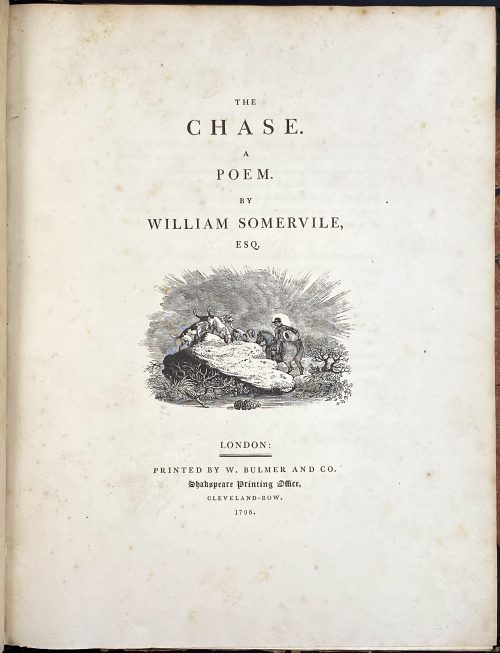 Royal 4to, 29.8 x 23.5 cm, contemporary half brown morocco, marbled boards gilt ruled, spine with gilt-ruled raised bands, gilt title lettering; "William Gore" armorial bookplate to front pastedown. Title page: THE | CHASE. | A | POEM. | BY | WILLIAM SOMERVILLE, | ESQ. | [VIGNETTE] | LONDON : | PRINTED BY W. BULMER AND CO. | Shakespeare Printing Office, | CLEVELAND-ROW. | 1796. Collation: without signatures. — Pagination: [i-v] vi-xv [xvi], [i] ii-vii [viii], [1-5] 6-126; illustrations: engraved title, 4 running titles, 4 headpieces, 4 tailpieces – 13 altogether, all drafted by John Bewick, 12 executed by Thomas Bewick and the last one by Charlton Nesbit. Catalogue Raisonné: Thomas Hugo. The Bewick Collector, vol. 1 (1866): p. 38, № 94: "The first edition... was printed in royal 4to". John Bewick made all the drawing on the blocks but was not able to execute the engravings himself "because of ill-health. They were engraved by Thomas Bewick, with the exception of the tail-piece at the end of the volume, which was engraved by Nesbit". Thomas Bewick (c. 11 August 1753 – 8 November 1828); John Bewick (1760 – 1795), the younger brother of Thomas, died at the age of 35. Christie's, who sold a similar copy on 29 Oct 2012, provides for the size 2°.
Royal 4to, 29.8 x 23.5 cm, contemporary half brown morocco, marbled boards gilt ruled, spine with gilt-ruled raised bands, gilt title lettering; "William Gore" armorial bookplate to front pastedown. Title page: THE | CHASE. | A | POEM. | BY | WILLIAM SOMERVILLE, | ESQ. | [VIGNETTE] | LONDON : | PRINTED BY W. BULMER AND CO. | Shakespeare Printing Office, | CLEVELAND-ROW. | 1796. Collation: without signatures. — Pagination: [i-v] vi-xv [xvi], [i] ii-vii [viii], [1-5] 6-126; illustrations: engraved title, 4 running titles, 4 headpieces, 4 tailpieces – 13 altogether, all drafted by John Bewick, 12 executed by Thomas Bewick and the last one by Charlton Nesbit. Catalogue Raisonné: Thomas Hugo. The Bewick Collector, vol. 1 (1866): p. 38, № 94: "The first edition... was printed in royal 4to". John Bewick made all the drawing on the blocks but was not able to execute the engravings himself "because of ill-health. They were engraved by Thomas Bewick, with the exception of the tail-piece at the end of the volume, which was engraved by Nesbit". Thomas Bewick (c. 11 August 1753 – 8 November 1828); John Bewick (1760 – 1795), the younger brother of Thomas, died at the age of 35. Christie's, who sold a similar copy on 29 Oct 2012, provides for the size 2°. -
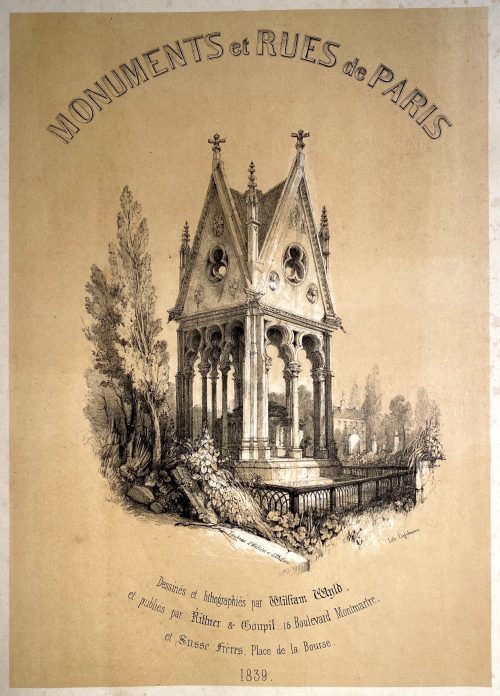 Pictorial album 55.5 x 41.0 cm, publisher’s quarter sheepskin over cloth, upper cover and flat spine lettered in gilt. Title: MONUMENTS et RUES de PARIS | Dessinés et lithographiés par William Wyld, | et publiés par Rittner & Goupil, 15 Boulevard Montmartre, | et Susse Frères, Place de la Bourse. | 1839. Collation: Title plate + 20 plates numbered from 1 to 20, printed by Godefroy Engelmann (French, 1788 – 1839) in tone lithography after drawings by William Wyld (British, 1806 – 1889). Published in Paris by Rittner & Goupil and Susse Frères in 1839. Plates: 54.8 x 39.8 cm. Contents:
Pictorial album 55.5 x 41.0 cm, publisher’s quarter sheepskin over cloth, upper cover and flat spine lettered in gilt. Title: MONUMENTS et RUES de PARIS | Dessinés et lithographiés par William Wyld, | et publiés par Rittner & Goupil, 15 Boulevard Montmartre, | et Susse Frères, Place de la Bourse. | 1839. Collation: Title plate + 20 plates numbered from 1 to 20, printed by Godefroy Engelmann (French, 1788 – 1839) in tone lithography after drawings by William Wyld (British, 1806 – 1889). Published in Paris by Rittner & Goupil and Susse Frères in 1839. Plates: 54.8 x 39.8 cm. Contents:Title page: Tombeau d'Heloïse et d'Abélard
- Le Pont Neuf
- L'église de la Madeleine
- La Porte St. Martin
- Palais des Tuileries
- Pont des Saints-Pères
- Hôtel de Ville
- Marché des Innocents
- Palais Royal
- Boulevard des Italiens
- Rue de la Paix
- Bourse et Tribunal de Commerce
- Porte St. Denis
- Pont Royal
- Place de la Concorde
- Paris from Père Lachaise
- Notre-Dame
- Jardin des Tuileries with Arc de Triomphe in the Distance
- Panthéon
- Chambre des députés
- Arc de Triomphe de l'Étoile
-
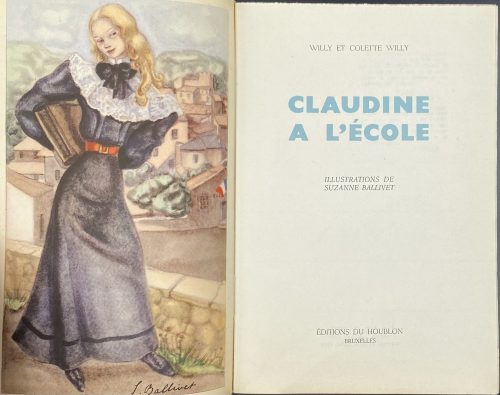 Title-page (turquoise and black): WILLY ET COLETTE WILLY | CLAUDINE | A L'ECOLE | ILLUSTRATIONS DE SUZANNE BALLIVET | ÉDITIONS DU HOUBLON | BRUXELLES || Front wrapper: WILLY ET COLETTE WILLY | {vignette} | ILLUSTRATIONS DE SUZANNE | CLAUDINE | A L'ÉCOLE || Description: French flapped wrappers, 21 x 14.5 cm, lettered front wrapper and spine, in glassine dustcover, paginated [1-8] 9-242 [6], 248 pages total, plus 8 photomechanical reproductions in colour after Suzanne Ballivet. Contributors: Sidonie-Gabrielle Colette [a.k.a. Colette] (French, 1873 – 1954) – author. Henry Gauthier-Villars [a.k.a. Willy] (French, 1859 – 1931) – author. Suzanne Ballivet (French, 1904 – 1985) – artist.
Title-page (turquoise and black): WILLY ET COLETTE WILLY | CLAUDINE | A L'ECOLE | ILLUSTRATIONS DE SUZANNE BALLIVET | ÉDITIONS DU HOUBLON | BRUXELLES || Front wrapper: WILLY ET COLETTE WILLY | {vignette} | ILLUSTRATIONS DE SUZANNE | CLAUDINE | A L'ÉCOLE || Description: French flapped wrappers, 21 x 14.5 cm, lettered front wrapper and spine, in glassine dustcover, paginated [1-8] 9-242 [6], 248 pages total, plus 8 photomechanical reproductions in colour after Suzanne Ballivet. Contributors: Sidonie-Gabrielle Colette [a.k.a. Colette] (French, 1873 – 1954) – author. Henry Gauthier-Villars [a.k.a. Willy] (French, 1859 – 1931) – author. Suzanne Ballivet (French, 1904 – 1985) – artist. -
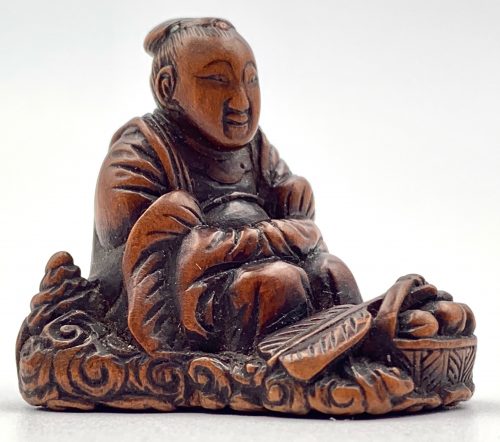 Wood netsuke of Seiōbo with a basket of immortal peaches, seated on a bed of clouds. Carver's signature tablet lost. Circa 1850. Dimensions: 32.6 x 28.1 x 20.1 mm.
Wood netsuke of Seiōbo with a basket of immortal peaches, seated on a bed of clouds. Carver's signature tablet lost. Circa 1850. Dimensions: 32.6 x 28.1 x 20.1 mm.Queen Mother of the West is a calque of Xiwangmu in Chinese sources, Seiōbo in Japan. Peaches of Immortality (Chinese: 仙桃) are consumed by the immortals due to their mystic virtue of conferring longevity on all who eat them.
Provenance: Charles Ephrussi (1849-1905) acquired in the 1870s; a wedding gift in 1898 to his cousin Ritter Viktor von Ephrussi (1860-1945) and Baroness Emilie (Emmy) Schey von Koromla (1879-1938); retrieved post-war by their daughter Elizabeth de Waal (1899-1991); given by her to her brother Ignaz (Iggie) Ephrussi (1906-1994), Tokyo; bequeathed by him to his great-nephew Edmund de Waal (born 1964), London, author of “The Hare with Amber Eyes: a hidden inheritance”. London / New York: Chatto & Windus / Farrar, Straus & Giroux. ISBN 978-0099539551. https://en.wikipedia.org/wiki/Charles_Ephrussi. https://en.wikipedia.org/wiki/Ephrussi_family. https://en.wikipedia.org/wiki/Edmund_de_Waal. -
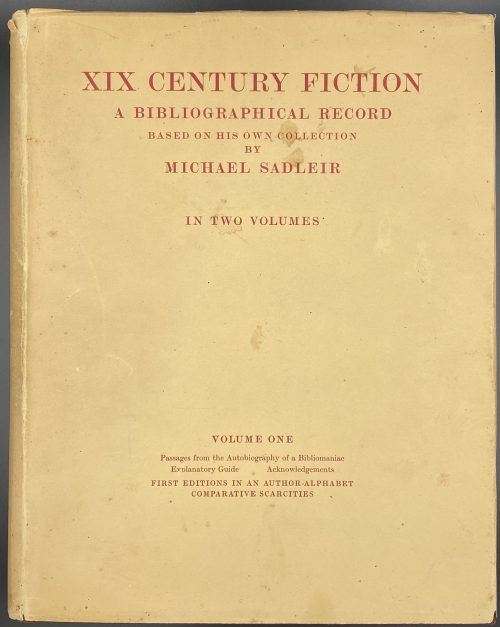 Title vol. 1: XIX CENTURY FICTION | A BIBLIOGRAPHICAL RECORD | BASED ON HIS OWN COLLECTION | BY | MICHAEL SADLEIR | IN TWO VOLUMES | VOLUME I | PRINTED AT THE UNIVERSITY PRESS, CAMBRIDGE | AND PUBLISHED | in Great Britain by | / CONSTABLE & CO LTD | 10–12 ORANGE STREET | LONDON W.C.2 / in the U.S.A. by the | CALIFORNIA UNIVERSITY | PRESS | LOS ANGELES, CAL.|| DJ vol. 1: XIX CENTURY FICTION | A BIBLIOGRAPHICAL RECORD | BASED ON HIS OWN COLLECTION | BY | MICHAEL SADLEIR | IN TWO VOLUMES | VOLUME ONE | Passages from the Autobiography of a Bibliomaniac | Explanatory Guide – Acknowledgements | FIRST EDITIONS IN AN AUTHOR-ALPHABET | COMPARATIVE SCARCITIES || Pagination: [4 blanks] ix-xxxiii, [2] 3-398 [399] [2 blanks] Collation: 4to; π2 [a]-d4 [1]-504. Title vol. 2: XIX CENTURY FICTION | A BIBLIOGRAPHICAL RECORD | BASED ON HIS OWN COLLECTION | BY | MICHAEL SADLEIR | IN TWO VOLUMES | VOLUME II | PRINTED AT THE UNIVERSITY PRESS, CAMBRIDGE | AND PUBLISHED | in Great Britain by | / CONSTABLE & CO LTD | 10–12 ORANGE STREET | LONDON W.C.2 / in the U.S.A. by the | CALIFORNIA UNIVERSITY | PRESS | LOS ANGELES, CAL.|| DJ vol. 2: XIX CENTURY FICTION | A BIBLIOGRAPHICAL RECORD | BASED ON HIS OWN COLLECTION | BY | MICHAEL SADLEIR | IN TWO VOLUMES | VOLUME TWO | “YELLOW-BACK” COLLECTION | FICTION SERIES || Pagination: [2 blanks] [8] [2] 3-195 [196 blank] [2 blanks]. Collation: 4to; π4 1-234 246. Binding: burgundy cloth, gilt vertical lettering to spine, Verity Hewitt (Canberra, AU) bookshop sticker to front pastedown; laid paper; cream DJ with lettering to front and spine. Edition: First limited edition of 1025 of which 1000 for sale. Unnumbered.
Title vol. 1: XIX CENTURY FICTION | A BIBLIOGRAPHICAL RECORD | BASED ON HIS OWN COLLECTION | BY | MICHAEL SADLEIR | IN TWO VOLUMES | VOLUME I | PRINTED AT THE UNIVERSITY PRESS, CAMBRIDGE | AND PUBLISHED | in Great Britain by | / CONSTABLE & CO LTD | 10–12 ORANGE STREET | LONDON W.C.2 / in the U.S.A. by the | CALIFORNIA UNIVERSITY | PRESS | LOS ANGELES, CAL.|| DJ vol. 1: XIX CENTURY FICTION | A BIBLIOGRAPHICAL RECORD | BASED ON HIS OWN COLLECTION | BY | MICHAEL SADLEIR | IN TWO VOLUMES | VOLUME ONE | Passages from the Autobiography of a Bibliomaniac | Explanatory Guide – Acknowledgements | FIRST EDITIONS IN AN AUTHOR-ALPHABET | COMPARATIVE SCARCITIES || Pagination: [4 blanks] ix-xxxiii, [2] 3-398 [399] [2 blanks] Collation: 4to; π2 [a]-d4 [1]-504. Title vol. 2: XIX CENTURY FICTION | A BIBLIOGRAPHICAL RECORD | BASED ON HIS OWN COLLECTION | BY | MICHAEL SADLEIR | IN TWO VOLUMES | VOLUME II | PRINTED AT THE UNIVERSITY PRESS, CAMBRIDGE | AND PUBLISHED | in Great Britain by | / CONSTABLE & CO LTD | 10–12 ORANGE STREET | LONDON W.C.2 / in the U.S.A. by the | CALIFORNIA UNIVERSITY | PRESS | LOS ANGELES, CAL.|| DJ vol. 2: XIX CENTURY FICTION | A BIBLIOGRAPHICAL RECORD | BASED ON HIS OWN COLLECTION | BY | MICHAEL SADLEIR | IN TWO VOLUMES | VOLUME TWO | “YELLOW-BACK” COLLECTION | FICTION SERIES || Pagination: [2 blanks] [8] [2] 3-195 [196 blank] [2 blanks]. Collation: 4to; π4 1-234 246. Binding: burgundy cloth, gilt vertical lettering to spine, Verity Hewitt (Canberra, AU) bookshop sticker to front pastedown; laid paper; cream DJ with lettering to front and spine. Edition: First limited edition of 1025 of which 1000 for sale. Unnumbered. -
 Iron tsuba of round form with design of wheel (kuruma) in openwork (sukashi). Squared rim. Copper sekigane. Yagyu school. Signed of the face: Fukui Tsuguzaemon. Early Edo period: Late 17th century (Kanbun/Enppo era). Height: 76.7 mm. Width: 76.8 mm. Rim thickness: 5.2 mm. Center thickness: 5.6 mm. Provenance: Sasano Masayuki Collection, № 203: "This design of spoke wheel relates to the 'circular principle' found in the Yagyu philosophy. Although it is very faint, Fukui Tsuguzaemon's signature is visible. Without a signature and based on appearance alone, it would undoubtable attributed to a later period".
Iron tsuba of round form with design of wheel (kuruma) in openwork (sukashi). Squared rim. Copper sekigane. Yagyu school. Signed of the face: Fukui Tsuguzaemon. Early Edo period: Late 17th century (Kanbun/Enppo era). Height: 76.7 mm. Width: 76.8 mm. Rim thickness: 5.2 mm. Center thickness: 5.6 mm. Provenance: Sasano Masayuki Collection, № 203: "This design of spoke wheel relates to the 'circular principle' found in the Yagyu philosophy. Although it is very faint, Fukui Tsuguzaemon's signature is visible. Without a signature and based on appearance alone, it would undoubtable attributed to a later period".Merrily Baird in her book "Symbols of Japan" [Merrily Baird. Symbols of Japan. Thematic motifs in art and design. Rizzoli international publications, Inc., 2001] provides the following explanation of the Wheel-of-the-Law symbol: "The Wheel-of-the-Law or Golden Wheel (rimbo, kinrin) has its origins in India, where it is known as chakra. [...] In Buddhist practice, it has been represented with eight spokes, reflecting the eight-fold path to overcoming worldly desire, and it signifies that all illusions will be crushed by the faith's enlightenment. [...] The Wheel-of-the-Law is an attribute of such deities as Senju Kannon, the Thousand-Armed Kannon, and Dainichi Nyorai, the all-illuminating solar figure who is the principal deity for Shingon Buddhism. From the Edo period on, the wheel also has been used in a secular manner", e.g. on family crests.
-
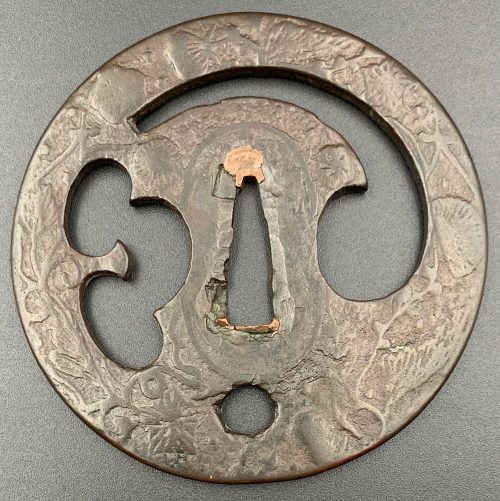
Yamagane (bronze) tsuba (kagami-shi, or mirror-maker) with the design of a star (round opening), tomoe (comma), and suhama in openwork. Surface cast and chiselled with the design of foliage, vines, blossoms, pine needles, and fruits on both sides.
The end of Early Muromachi period (1393-1453), circa 1450. Size: 83.7 x 84.1 x 3.6 (center), 4.1 (rim) mm; weight: 135.5 g. KANTEI-SHO (鑑定書) - APPRAISAL [translated by Markus Sesko]. No 463341 Tomoe-suhama-sukashi hana-karakusa no zu tsuba (巴洲浜透花唐草図鐔) ‒ Tsuba with stylized comma and bay inlet openwork and a flower and arabesque décor Unsigned: Kagami-shi (鏡師) Round shape, yamagane, hammer blow finish, cast, negative openwork design, round rim. According to the result of the shinsa committee of our society, we judge this work as authentic and rank it as Hozon Tōsōgu. July 1, 2011 [Foundation] Nihon Bijutsu Tōken Hozon Kyōkai, NBTHK (日本美術刀劍保存協會) -

Yamagane (bronze) tsuba (kagamishi, or mirror-maker) with the design of tomoe (comma) and suhama in openwork. Surface treated with hammer marks and chiselled with the design of maple leaves and encircled two bars (maru-ni-futatsu-biki, Ashikaga clan family crest, or mon) on both sides. Raised rim or rim cover (fukurin). Custom kiri-wood box.
Size: 87.4 x 86.2 x 2.9 (center), 4.9 (rim) mm; weight: 120 g. -

A yamagane tsuba of oval form with green-ish black patina decorated in usuniku-bori carving and gold iroe with wisteria (fuji) motif plus nanako-ji ground on both sides. Kozuka-hitsu-ana possibly cut later.
Unsigned.
Momoyama or may be even Muromachi period. Dimensions: 70.0 x 61.2 x 5.0 (center) mm -

Oblong round shape (nagamaru-gata) tsuba with design of dragonfly (tombo or katsumushi) and wheel (kuruma) in negative openwork (kage-sukashi), round rim (maru-mimi ). Copper sekigane.
Okamoto Yasukazu's Owari to Mikawa no tankō, №181 characterizes the tsuba as follows: "Katsumushi, kuruma-sukashi no zu (dragonfly and wheel sukashi). Mei: Yamakichibei (Shodai). Such small tsuba are rare for the Shodai. The nakago-ana is also small so it was probably intended to be mounted on a tantō. Regardless of its size, the iron is outstanding and the workmanship shows the characteristic features of the Shodai (first generation). The kuruma-sukashi design is interpreted here in a half-moon shape and only on one side of the tsuba. Such a design is also seen on works of the Nidai (second generation)...". Signed to the left of nakaga-ana: Yamakichibei (山吉兵へ). Attributed to the First Generation (Shodai) master.
NBTHK paper (translated by Markus Sesko): The Tokubetsu-Kichō Kodōgu. Kachimushi-kuruma sukashi-tsuba (勝虫車透鐔) - Tsuba with sukashi motif of dragonfly and cartwheel. Signed: Yamakichibei (山吉兵). Iron, marugata, ko-sukashi. Issued on April 1, 1977. [Copy only] Dimensions: H: 66 mm; W: 63.2 mm; Th(center): 3.8 mm; Th(rim): 3.5 mm. Weight: 68 g.


